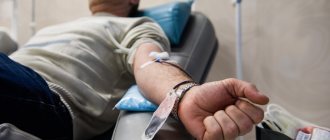Blood sampling is one of the mandatory procedures during an annual medical examination, but not all people tolerate it well. According to official statistics, about 3-4% of the planet's population shudders at the sight of blood or the realization that in the near future this liquid connective tissue will end up outside, and not inside, the body. What is the cause of this condition and is it possible to fight it?
In this article:
What is hemophobia and why is the fear of blood inherent in every person? How does the fear of blood manifest itself? Symptoms and signs of hemophobia. What is the fear of blood associated with? Which celebrities are susceptible to the fear of blood? Why do you need to get rid of the fear of blood? Techniques for treating hemophobia How to learn not to be afraid of blood
What is hemophobia and why is the fear of blood inherent in every person?
Photo by Oleg Magni: Pexels
From the ancient Greek language, the term “hemophobia” is translated as “fear of blood.” This condition is a mental disorder and is one of the 30 most common types of fears in the world. According to statistics, it affects from 200 to 400 million people of all ages.
At the same time, it is customary to distinguish between a phobia (accompanied by panic or severe discomfort) and a person’s basic instincts.
You may not be a hemophobe, but be wary or feel internal discomfort at the sight of blood.
These are normal protective mechanisms that have their origins in the distant past and are transmitted at the genetic level. It's simple: you need to make sure that you don't experience blood loss and stay healthy.
But in the case of a phobia, these body reactions are squared. As a result, multiple excessive reactions of the body occur, by which this mental disorder can be identified.
What is Hemophobia
Hemophobia is a spontaneous, uncontrollable, illogical obsessive fear of blood . The term was introduced into scientific use in 1972 by the American psychiatrist D. Weinberg. He described the typical manifestations of the disorder and indicated the causes of the disease.
Manifestations of phobia
Hemophobia manifests itself in different ways. There are people who, anywhere, under any circumstances, lose consciousness at the sight of just a drop of blood. And there are those who feel discomfort only in a medical institution or at the sight of a serious wound. Blood phobia is a very insidious disease, because most sufferers, until a certain point, are not even aware of their pathology.
The disease appears suddenly, at the most inopportune time. For example, you need to provide emergency medical care, stop bleeding, or become a donor. And instead of performing specific actions, the hemophobe panics, he begins to feel nausea, dizziness, and may faint. A panic attack can begin in the manipulation room at the sight of test tubes with blood.
The first attacks of unconscious anxiety are usually short-lived.
They are accompanied by subjective unpleasant sensations that cause discomfort and provoke a new round of fear of blood:
- increased sweating,
- pallor or redness of the skin,
- severe choking, trembling and (or) numbness of the arms, legs,
- chills, headaches,
- cardiopalmus.
After the first attack of blood phobia, some patients cheat themselves when taking tests, cutting meat, or cleaning fish. They remove all sharp and cutting objects from the house. Such behavior indicates that the fear of the sight of blood develops into a mental disorder. Children who cannot control their fear are especially susceptible to this process.
The acute degree of manifestation of hematophobia is characterized by a rapid reaction of the nervous system, responding to the visual signal of the type of blood. The panic attack is so severe that the patient feels as if he is going crazy.
The clinical picture is created by the following symptoms:
- urge to vomit,
- taste of blood in the mouth,
- slow thinking,
- flickering of flies before the eyes,
- loss of consciousness.
A classic hematophobe experiences inexplicable anxiety even when watching films with scenes of violence, discovering a scratch or cut on himself, or unwittingly witnessing an accident. Studies conducted by Russian psychiatrists indicate that the level of fear is approximately the same when seeing one's own and someone else's blood.
How does the fear of blood manifest itself?
Agree, seeing a pool of blood in person, you will definitely feel discomfort caused by the reluctance to see the creature (human or animal) from which it flowed. Another reason why you will bypass such a find lies in the likelihood of a crime. You probably don't want to be the next victim. And that's okay.
What is hemophobia?
Hemophobes are afraid of blood not only in large quantities. They are frightened, among other things, by the very realization that the injury will be followed by a physical manifestation of this tissue. Cutting your finger, getting an injection, getting your blood tested is a real stress for people suffering from hemophobia.
conclusions
Blood phobia is an obsessive state of unconscious anxiety that complicates the patient’s life, “prohibits” him from engaging in active sports, and does not allow him to fully take care of his health. What is dangerous is not the feeling of fear, but the subconscious desire to avoid a traumatic situation for the psyche: refusal to visit the clinic, donate blood for analysis, or treatment.
Hemophobes stop eating meat, hide knives, razors, scissors, forks in inaccessible places, and wrap soft fabrics around the sharp corners of furniture. They are treated mainly with herbal infusions, spells, and meditations.
To stop being afraid of the sight of blood, you should carry out psychotherapeutic correction, suppress panic, and adapt to society. It is necessary not to run away from fear, but to boldly look into its eyes, overcome yourself, and the fear of blood will recede. Of course, sick people, adults or children, must be treated with understanding, without rudeness or insults. And always remember - a person must become stronger than doubts, anxieties, illogical fears, then he will be the master of his destiny.
Topic: Mental health, Overcoming fears
Symptoms and signs of hemophobia
There are a number of signs characteristic of the behavior of hemophobes. So, the following manifestations of this mental disorder are common:
- sudden attacks of tachycardia;
- lowering blood pressure;
- pulsation in the temporal zone;
- dizziness;
- pale skin;
- tremor of the limbs;
- dilated pupils;
- increased nervousness;
- breathing problems;
- fainting states.
A sharp decrease in blood pressure in this case is a protective mechanism. It slows down blood circulation and, accordingly, reduces the risk of blood loss. The same factor leads to fainting, since insufficient blood enters the brain, briefly “switching off” it.
Clinical blood test indicators
A general blood test must contain the following indicators:
- hemoglobin;
- red blood cells;
- color index;
- reticulocytes;
- platelets;
- leukocytes;
- neutrophils;
- eosinophils;
- basophils;
- lymphocytes;
- monocytes;
- ESR (erythrocyte sedimentation rate).
If necessary, the doctor may prescribe an extended clinical blood test. In this case, he will specifically indicate which indicators should be additionally included in the analysis.
What is the fear of blood associated with?
Fear of injections and any medical procedures that may be accompanied by blood sampling, injections, or surgery is one of the few components of hemophobia. The basis of this fear is the possible pain that can accompany any of the listed manipulations.
Factors that provoke hemophobia include:
- history of phobia;
Giphy
- traumatic experience (seeing or experiencing an accident can provoke a fear of blood at any age, but this problem is especially relevant among children and impressionable people);
- negative impact on the psyche (watching “bloody” films, scenes of violence, crime chronicles).
In severe cases of hemophobia, you are afraid of death, which you consider to be a logical consequence of blood loss. The point is that this fear is too exaggerated and increased in scale: mentally you understand that you will not die if you submit this liquid connective tissue for analysis, but in fact you reject the arguments of reason and lose control over somatics.
Theories about the origin of blood phobia
- There are no real reasons for the occurrence of hemophobia and... Isolated cases of the development of panic fear after unsuccessful medical procedures that were accompanied by bleeding are an exception to the rule.
- Blood phobia affects impressionable and suspicious people who are able to empathize and sympathize with others. Creative individuals with a delicate nervous system are susceptible to pathology. But people with a pedantic mindset do not suffer from hemophobia.
- Some psychotherapists believe that the main reason that causes fear of blood is hereditary fear. The lack of doctors, medicines, and the dangers that awaited our ancestors at every step required caution - any injury could be fatal. This is where, in their opinion, instinctive panic fear arose. But observations of the development of identical twins have proven that there are no genetic prerequisites for the development of a phobia - fear of the sight of blood.
Which celebrities have a fear of blood?
Sometimes hemophobia develops in adults and mentally balanced people against the background of certain health problems in the environment. For example, Nicholas II was afraid of the sight of blood because of a hereditary disease of his son Alexei. The boy had hemophilia - a blood clotting disorder that could have caused his sudden death from hemorrhage in the brain and other organs.
A modern celebrity, the star of the TV series “Streets of Broken Lights,” Anastasia Melnikova, also “earned” hemophobia due to her environment, but for a different reason. The father of the future actress, an oncologist surgeon, somehow decided to introduce his daughter to the work dynasty and brought her to the operating room. While the experiment was a success with Melnikova’s brother, it wasn’t for her. The girl lost consciousness at the sight of the syringe and blood.
Hemophobia and its varieties
A person susceptible to hematophobia may experience various concerns and fears. Depending on what is the subject of alarm, the following types are distinguished:
- Fear of the sight of any blood;
- Fear of blood loss.
Easy stage
Hematophobia in a mild stage causes anxiety in a person when he learns about the need to donate blood for analysis. Manifestations of this include nervousness and pallor. A person cannot switch to another thought; he is focused only on the upcoming sight of blood.
Severe stage
When the disease is advanced, the hemophobe experiences panic attacks; all manifestations characteristic of the mild stage become acute; loss of consciousness and fainting are possible.
The video shows the manifestation of a phobia in a stressful situation. It is very likely that after this incident the person will acquire a more serious degree of phobia:
https://youtube.com/watch?v=Ni7DDW6X31Q
Why you need to get rid of the fear of blood
No, no one will force you to watch horror films and scenes of cruelty if you love cartoons and comedies with a happy ending. But objectively, inadequate fear and the accompanying symptoms reduce the quality of your life.
You can’t go to the doctor “without incident”, you often feel bad (because your fantasy “inflates” a whole puddle of blood from any ketchup stain), and so on.
Sometimes you categorically refuse to make contact with people who want to provide you with simple medical assistance. For example, a bleeding scratch on your knee in your thoughts becomes overgrown with the prospect of amputation, so you distance yourself from those around you who intend to treat the wound with peroxide.
In cases where the fear of blood is not associated with defense mechanisms, it must be gotten rid of at least in order to be able to live fully and enjoy life.
Why do you need a general blood test? Why is this analysis so important?
Blood is a special tissue that transports various substances between other tissues, organs and systems, while ensuring the unity and constancy of the internal environment of the body. Thus, most processes affecting the condition of various tissues and organs, one way or another, are reflected in the condition of the blood.
Blood consists of plasma (the liquid part of the blood) and formed elements - leukocytes, platelets, erythrocytes. Each type of formed element has its own functions: leukocytes are responsible for immune defense, platelets for blood clotting, red blood cells provide transport of oxygen and carbon dioxide.
In a healthy person, the composition of the blood is fairly constant, but in case of illness it changes. Therefore, with the help of a blood test, it is possible to determine that the disease exists. Sometimes a general blood test can detect the disease at an early stage, when the main symptoms of the disease have not yet appeared. That is why OAC is performed during any preventive examination. If symptoms are present, clinical analysis helps to understand the nature of the disease and determine the intensity of the inflammatory process. Clinical analysis is used to diagnose various inflammatory diseases, allergic conditions, and blood diseases. A repeat general blood test will give the doctor the opportunity to judge the effectiveness of the prescribed treatment, assess the trend towards recovery and, if necessary, adjust the course of treatment.
Treatment techniques for hemophobia
Successful treatment of any phobia is possible if it is accepted. That is, initially you should not look for arguments in favor of your fear, but agree with its irrationality.
Photo by Edward Jenner from Pexels
You can then resort to forms of treatment such as:
- consultation - contact a psychiatrist who will help identify the root cause of the phobia and develop a treatment regimen;
- hypnosis - a good specialist will help you on a subconscious level to reconsider your attitude towards a situation that leads to paralyzing fear, and based on a new attitude towards the problem, you will be able to get rid of it;
- Cognitive-behavioral correction – involves blocking fear at the hormonal level, which promotes psychological and physical control. In practice, this implies systematic contact with the subject of fear in order to form and consolidate positive reactions to it.
Sedatives prescribed by a specialist will be an optional, but auxiliary factor in recovery.
Treatment[ | ]
- In Sweden, a study was conducted among 30 patients suffering from hemophobia, which showed that in 60% of cases, patients were able to get rid of the phobia after one two-hour therapeutic session using the “applied tension” method, the essence of which is that the therapist teaches the client to psychosomatically increase your blood pressure and heart rate. With this therapy, the patient is less likely to faint at the sight of blood. A year after treatment, the patients were re-examined and successful cure was confirmed;
- Exposure therapy;
- Cognitive therapy;
- Relaxation;
- In severe cases, drug treatment may be prescribed.
How to learn not to be afraid of blood
Since blood, with rare exceptions, is an integral part of living beings, it is normal to perceive its appearance, if not a mandatory, then a desirable skill. If you have hemophobia, you can accustom yourself to adequate mental reactions to the sight of this tissue:
Photo by Anna Shvets: Pexels
- control your breathing (alternating deep breaths and exhalations will help stabilize your heartbeat);
- squat or jump up the moment you feel yourself starting to lose consciousness. This way you will speed up blood circulation and, accordingly, blood supply to the brain.
To prevent blood phobia, you can try to eliminate factors that cause panic associations with the subject of fear (don’t look at cruelty, don’t listen to crime news).
How to take a general blood test. Preparing for the UAC
Blood for a general blood test can be taken either from a finger or from a vein.
It is advisable to take the test on an empty stomach. If the test is taken during the day, then at least 4-5 hours should pass after the last meal. However, this requirement is not strict.
Be sure to avoid eating fatty foods the day before. You cannot take a test while there is alcohol in your blood, or after an X-ray examination, physical therapy, or sunbathing.
If you are taking any medications, be sure to tell your doctor: some medications can affect your blood composition.
For women undergoing routine examination, it is advisable to wait until the end of their period for analysis. If a general blood test is prescribed during the treatment of a disease, you can donate blood regardless of your period - the doctor will take this into account when interpreting the results.
Types of hemophobia
Fear of blood has several subtypes. The following subtypes of fear can be distinguished:
- fear of seeing someone else's blood;
- fear of the sight of one's own blood;
- fear of seeing animal blood;
- fear of seeing any blood.
If a person is afraid of his blood, then this may also be due to the fear of pain. And if he is afraid of someone else's blood, then this may be due to the fear of punishment or the fear that he will not be able to help another.
Fear of donating blood
With this form of fear, panic grips a person long before the procedure begins. In this case, it is recommended to distract yourself, read a book or watch a movie on your phone. When entering the office, you need to immediately warn the medical staff about your phobia and that you are having a hard time with the procedure. After this, your fear of embarrassing yourself will decrease, and the nurse will immediately take all the necessary measures, for example, take a thinner needle and put you on the couch (in this position the blood circulates better).
It is important! Make it a rule not to look at the needle or the procedure itself. Turn away and imagine something pleasant or talk to the medical staff.
How to get rid of hemophobia yourself
To self-correct the condition, psychologists have developed a special five-step technique that tells you how to get rid of hemophobia. Let's look at each of the steps in more detail.
Talk
Sometimes simply speaking your thoughts out loud helps you realize the irrationality of your experiences and overcome anxiety. Contact a psychologist, a close friend, or talk to yourself about everything that worries you. Try to reason, find the root cause of fear, talk about its consequences and impact on your life. Such reasoning helps not only to change the attitude towards the problem, but also to find a way out of the current situation.
Exercises
In moments of panic or when you feel like you are about to lose consciousness, do the following exercises:
- For five minutes, tense all the muscles of your body one by one. Start by clenching your fists and move up, then move to your shoulders, chest, stomach, legs. Practice this technique every day, then during an attack you will definitely not forget about it. This technique allows you to restore blood circulation and reduce the level of cortisol, the stress hormone.
- Take 20 quick breaths. This will help quickly saturate the brain with oxygen.
Meditation
Meditation allows you to calm down and look inside the subconscious. This technique allows you to understand the connection between soul and body, teaches you to hear the soul and the body. The essence of meditation is to concentrate on your feelings, abandon any thoughts and ask yourself: “why are you afraid of blood?” You may not hear the answer right away, but if you practice meditation daily, you will learn to understand yourself.
How to meditate correctly to get rid of the fear of blood:
Choose a convenient time and place, make sure there are no distractions. Find a comfortable position
It is not necessary to sit in the lotus position, but your back should be straight. Try to relax your body with the power of thought.
After this, pay attention to your breathing. Say a mantra (positive affirmation)
You can supplement this stage with visualization.
If you catch yourself on extraneous sensations and thoughts, then immediately return to a relaxed state by force of will. Switching will happen less and less each time.
Psychotherapy
If the fear of blood is beyond your control, the fear of blood has reached such proportions that you cannot take the necessary test, or you have locked yourself within the walls of the house and thrown out all the sharp objects, then it is time to consult a psychotherapist. As part of the professional treatment of hemophobia, psychoanalysis, cognitive behavioral psychotherapy, hypnosis, and gestalt therapy are used. A specialist will study your case and select the optimal treatment. If necessary, the psychologist will prescribe sedatives.
How to overcome your fear of blood on your own
Try to communicate as much as possible with those who are not afraid of blood, but take your phobia seriously. Find out the stories of people who have suffered serious injuries or recovered from major blood loss. Think about what exactly scares you. Now you know emergency self-help methods, you don’t have to worry about fainting.
Symptoms of hemophobia
First of all, this phobia manifests itself in the form of an uncontrollable, unconscious fear, which is expressed at the level of a panic attack, in front of the appearance of blood. This can be either a person’s own blood after an injection or a cut, or someone else’s, including an animal. Associated symptoms of hemophobia: pallor, excessive sweating, noticeable tremor of the hands, fear is noticeable in the individual’s eyes, the pupils “run,” breathing quickens along with the heartbeat. Such people have a very difficult time withstanding, and therefore, in fact, are afraid of, all kinds of medical tests, including vaccinations.
The fear of blood manifests itself quite suddenly, at the exact time of a panic attack. The manner in which this phobia manifests itself is impossible to predict. Initially, this may be a short-term anxiety attack. It is accompanied by a number of subjective unpleasant sensations of the individual, which cause discomfort and are often themselves a cause of fear. The patient is worried about severe suffocation, chills and dizziness, limbs go numb, internal trembling is felt, nausea, and thinking is inhibited. This condition is regarded as a very strong signal of danger. During a panic attack, many hemophobes feel like they might go crazy or even die, so they try to avoid such situations by all available means.











